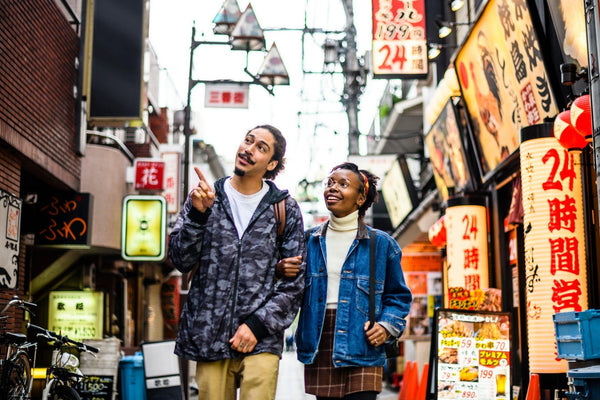
Jump to:
If you've been to Japan before, there is a pretty good chance that you're already planning your next trip back here.That's because, with very good reason, Japan has become one of the most popular travel destinations in the world.
That first magical trip to Japan probably left you wanting more. After experiencing the bright lights of Tokyo, the shrines & temples of Kyoto, riding on the bullet train and eating so much amazing food, you're ready to dig deeper into what makes this country so captivating.
That's why we've prepared a guide for your second trip to Japan. In this edition of the Japanese taste blog, we will explore traveling to Japan for your second (or 3rd or 4th or 5th or more) trip back here – what to see and do, how to delve deeper and how to make the most of your travel experience in Japan this time.
Things to Do on a Second Trip to Japan
Much of Japan's charm exists in its layers.
Your first visit likely focused on the postcard-famous spots and must-see landmarks. You hit some of the highlight reel and checked off a lot of the big sites and experiences. Unless you got a taste for Japan, both figuratively and literally, you want to travel again and see more in depth.
That’s great! Now you can slow down and savor experiences that most first-time tourists rush past or overlook when visiting Japan.
-
Explore Local Festivals with Authentic Cultural Vibes

© Kengo Maeda
Local festivals offer the perfect starting point. Unlike the major celebrations that fill travel guides, these intimate gatherings maintain their authentic community spirit.
In September, the streets of Toyama prefecture come alive during the Owara Kaze-no-Bon festival. Local residents dance through lantern-lit neighborhoods as minzoku-bayashi folk music fills the air. You won't find tourist bleachers or souvenir stands; just genuine cultural celebration passed down through generations.
2. Discover Japanese Arts and Crafts with Master Artisans

© Adam Marelli
Japanese arts and crafts take on new meaning when you meet the artisans keeping these skills alive. In the quiet workshops of Tokushima, indigo masters transform white cloth into deep blues using techniques refined over centuries.
The small city of Wajima still produces lacquerware using methods that date back to the Edo period. These artisans often welcome visitors to try their hand at these ancient crafts, creating both beautiful souvenirs and lasting memories.
3. Stay at Family-Run Ryokan Inns and Experience Traditional Japanese Life
Family-run ryokan inns and minshuku guesthouses provide accommodation with a side of cultural immersion. Unlike standard hotels, these smaller lodging options offer a better look into Japanese life.
Seasonal activities might include gathering mountain vegetables, helping to prepare traditional dishes or joining in neighborhood festivities. Many hosts take pride in sharing local knowledge that guidebooks miss entirely.
Places to Visit if You've Already Been to Tokyo, Kyoto, Osaka, Hiroshima & Nara
Japan's depth becomes apparent when you venture beyond its famous cities. Each region maintains its own character, cuisine and cultural traditions worth discovering.
1. Kanazawa - Creative City
Kanazawa emerged from World War II largely untouched, preserving much of its historical architecture and traditional arts. While often compared to Kyoto, the city maintains its own distinct identity. The famous Kenroku-en garden showcases different faces across the seasons, from spring cherry blossoms to winter's yukitsuri snow-protection ropes.
In the old Higashi Chaya district, travelers can experience traditional tea houses, while artisan shops sell local crafts without the hyper-tourist-market atmosphere found elsewhere.
2. Matsue - Castle Town
The castle town of Matsue sits between Lake Shinji and Nakaumi Lagoon, creating an atmospheric setting that captivated writer Lafcadio Hearn over a century ago. The morning mist rolling off the water adds mystery to the black castle walls, while small wagashi shops prepare traditional sweets using recipes passed down through generations. Tea ceremony traditions remain strong here, with many opportunities to sample matcha in historic settings.
3. Takayama - Festivals
High in the Japanese Alps, Takayama preserves the feel of old Japan without trying too hard. Its morning markets have operated continuously for hundreds of years, selling local crafts and produce. Twice yearly, Takayama hosts festivals featuring elaborate wooden floats, masterpieces of local carpentry traditions. The surrounding mountains offer hiking in warmer months and skiing in winter, with natural onsen hot springs perfect for soaking year-round.
4. Fukuoka - Vibrant Street Food Scene
Fukuoka serves as more than a gateway to Kyushu. This sizable city balances modern shopping districts with shrines, temples and archaeological sites that tell the story of Japan's history – and its earliest connections with mainland Asia.
As night falls on Fukuoka, the famous yatai food stalls create impromptu restaurants along the riverside. These tiny establishments serve some of Japan's best street food in an atmosphere that encourages conversation with fellow diners.
5. Nagoya - Castle and Parks
Nagoya is another often-overlooked Japanese city. It’s the fourth largest in Japan, but doesn’t get a whole lot of visitors, at least not compared to Kyoto.
Among the city’s most exciting new attractions is Studio Ghibli Park, a dream destination for fans of Japan’s iconic animation studio. Located in Aichi’s Expo 2005 Memorial Park, Studio Ghibli Park brings beloved worlds like My Neighbor Totoro and Spirited Away to life.
Check out our articles on Nagoya’s food scene as well as the top 10 things to do in Nagoya. If you’re a nature lover, Japan’s got tons of national parks. Choose one or more that strike your fancy, based on climate, features, activities and more.
Foods That You Might Have Missed on Your First Trip to Japan
Japanese cuisine extends far beyond the familiar sushi restaurants and ramen shops that visitors typically encounter first. Each region takes pride in its local specialties, using ingredients and cooking methods particular to the area.
1. Hokkaido Specialties
Hokkaido's harsh winters gave rise to hearty dishes like Ishikari nabe. This warming salmon soup showcases the northern island's incredible seafood, combining it with root vegetables and tofu in a miso-based broth. Local dairy adds depth and character rarely found in other Japanese regions. Hokkaido is also famous for soup curry, jingisukan, Hokkaido milk biscuits, and (of course) miso ramen. If you want more information, here’s a good rundown on everything you need to eat in Hokkaido!
2. Yamanashi’s Hoto Noodles
In Yamanashi prefecture (much of which is in the shadow of Mount Fuji), hoto noodles provide sustenance after days spent hiking or visiting local wineries. These thick, flat noodles come served in a rich soup often featuring locally grown pumpkin. The dish dates back centuries, connecting modern diners with the region's farming heritage.
3. Kagawa’s Sanuki Udon
Kagawa prefecture takes particular pride in its sanuki udon noodles. The firm, chewy texture comes from a particular type of wheat and traditional kneading methods. Local shops serve these noodles in styles ranging from hot soup to cold dipping varieties, each highlighting the noodles' distinctive qualities.
4. Nagasaki’s Shippoku Ryori and Champon
Nagasaki's history as a trading port created shippoku ryori, a unique fusion of Japanese, Chinese and European cooking styles. Multi-course meals might include local seafood prepared with Portuguese influences alongside Chinese-inspired dishes, all served in a distinctly Japanese style. Nagasaki’s signature dish is called champon, a noodle soup that’s not totally unlike ramen and whose name literally means “mixed up.”
5. Regional Sake Varieties
Regional sake varieties complement these local foods perfectly. Small breweries produce limited batches using local rice varieties and water sources, creating distinct flavors that pair naturally with area specialties. Many offer tasting rooms where you can sample their products and learn about traditional brewing methods.
If you’re visiting Osaka or Kyoto, take a day trip to Kobe, famous not just for Kobe beef (though that’s great) but for its numerous sake breweries.
6. Japanese Cookies and Sweets
For travelers with a sweet tooth, Japan’s unique selection of cookies and sweets offers delightful surprises beyond the typical fare. Each region has its own specialty treats that make perfect souvenirs, showcasing traditional Japanese flavors with a modern twist.
If you’re interested in bringing a taste of Japan home, check out our article on Japanese cookies as souvenirs. Many of these treats are beautifully packaged, making them ideal as gifts or for sharing a bit of Japanese culture with friends and family.
Benefits of Traveling Off the Beaten Path in Japan
Traveling off the beaten path in Japan opens up a world of authentic experiences. Here are my top three reasons why I love the places beyond the major tourist spots:
- Experience regional diversity and escape the crowd - Moving away from major tourist routes lets you explore and experience Japan's incredible regional diversity. Local pride manifests in distinct dialects, customs and crafts maintained through generations of dedicated practitioners. These areas maintain their own pace of life, free from the tourist-focused atmosphere of major destinations.
- Save on costs - Practical benefits include lower costs for transportation, accommodation and meals. Hotels and restaurants in smaller cities often provide excellent value while maintaining high standards of service and quality. Without the premium pricing found in major tourist areas, you can enjoy longer stays or upgrade your experience.
- Build meaningful conections - Many Japanese people in less-visited areas welcome the chance to interact with international visitors. Simple English exchanges often blossom into warm conversations about local life and culture. These genuine interactions create lasting memories and deeper understanding than any quick hit-and-run itinerary can provide.
Souvenirs from Other Areas in Japan
Each region's distinct character shows through in its local products and crafts. These items make meaningful souvenirs that go beyond the standard offerings found in airport gift shops.
In Okinawa, local potters create shisa lion figures that guard homes and businesses throughout the islands. Each artist adds personal touches to these traditional designs. The subtropical climate influences everything from the bright patterns of bingata textiles to the distinct flavor of aged awamori spirits. Be sure to eat local when you’re in Okinawa, too!
Hokkaido's craft traditions reflect its natural resources and harsh climate. Woodworkers create beautiful items using native timber, while small fishing villages produce dried seafood products prized throughout Japan. The region's famous dairy appears in limited-edition sweets and snacks unavailable elsewhere – hello, Shiroi Koibito & ROYCE’ chocolates!!
Nagano's long winters historically provided time for developing craft traditions. Paper makers use natural dyes to create distinctive patterns, while ancient kilns produce pottery styles unique to the region. Mountain vegetables preserved according to traditional methods make portable gifts that capture local flavors.
Aomori prefecture's apple orchards produce more than just fresh fruit. Small family operations create products ranging from jams to drinks, each highlighting different apple varieties, such as these apple pie sticks from Aomori. The region's kokeshi dolls and lacquerware showcase distinct local patterns and techniques passed down through generations.
Welcome Back to Japan!
A second visit to Japan allows you to experience these deeper layers of Japanese culture. Moving beyond the standard tourist circuit opens opportunities for genuine cultural exchange and discovery. You might find yourself joining a neighborhood festival, learning family recipes or spotting wildlife in remote mountain villages.
Welcome back! We’re glad you liked your first time so much that you (like so many others) were compelled to return.
Got any questions? Feel free to ask in the comments below! We’d love to hear from you.















0 comments